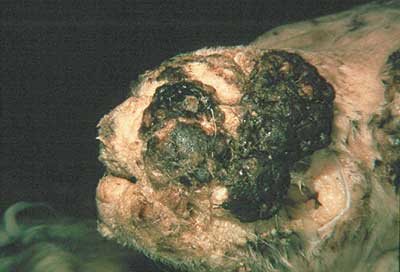Parasites and Diseases
Contagious Ecthyma
A Field Guide
TO COMMON WILDLIFE DISEASES
AND PARASITES IN ALASKA
CONTAGIOUS ECTHYMA

Dall sheep with scabby ecthyma lesions on muzzle.
| What causes ecthyma? |
- Contagious ecthyma is caused by a virus spread by direct contact with scabs on infected animals.
| Where does ecthyma occur? |
- Ecthyma occurs throughout Alaska wherever Dall sheep, muskox or mountain goats are found.
- It is most common and severe in younger animals.
- Humans can also be infected.
| What are the signs of ecthyma? |
- Pus-filled blisters form into thick scabs on the head, mainly on the lips, mouth, nose, eyelids, and ears.
- Scabs on the mouth may make it difficult or painful for animals to eat.
- Scabs can also occur on the udder and the top of the foot just above the hoof.
- If scabs are on the feet, animals may be lame.
- Animals that are heavily infected may be weak.
| How can I protect myself? |
- You can get ecthyma by touching scabs on an infected animal or by touching anything that has come in contact with the scabs. The virus enters through cuts or scratches in your skin or through your eyes, nose or mouth.
- Wear gloves.
- Do not cut into blisters or scabs.
- Wash your hands, knives, and clothes with hot soapy water after you finish butchering.
| Can I eat the meat? |
- Meat from an infected animal is suitable for human consumption.
- Trim off affected parts.
- Severely infected animals may be in poor condition, reducing the quality of the meat.
| Samples to collect |
- Scabs and surrounding area
- To report an occurrence or to submit a sample for identification/analysis, contact the DWC Wildlife Disease Surveillance reporting hotline 907-328-8354, send an email to dfg.dwc.vet@alaska.gov or visit your local ADF&G office.
